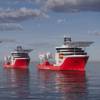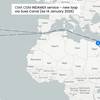On January 23, 2003, having experienced main engine failure and at the mercy of storm force wind and seas, the crew of the 7,598 dwt RoRo vessel Camilla requested the Canadian Coast Guard air evacuate them from the ship with the Coast Guards Cormorant helicopter fleet.
The evacuation was performed without incident and the 17-man crew was safely transported to St. John's Newfoundland. Winching 17 men from the deck of a storm tossed ship in the North Atlantic is no simple task and required the Cormorant helicopter to refuel from oil platforms off the Canadian coast.
Mobilizing off Salvage Station north of Bermuda, the International Transport Contractors Management (ITC) Salvage/Icebreaking tug Kigoria 297 x 56 ft. (90.7 x 17.2 m) 16,800 bhp and 196 TBP) was already underway to the casualty. Having worked together with Titan on many salvage operations, ITC asked Titan Maritime, LLC (Titan) to join forces in this rescue operation and the combined capability of Titan/ITC was offered to owners under the terms of a Lloyds Open Form (LOF) 2000 contract.
Titan immediately responded by mobilizing a four-man strike team, consisting of a Salvage Master, Assistant Salvage Master, Salvage Engineer and Salvage Emergency Medical Technician to St. John's, Newfoundland, where they were met by ITC's Salvage Master and Naval Architect. The Titan/ITC strike team intended to be flown by helicopter to the Camilla and be lowered aboard to make a towing connection to the Kigoria and to stabilize the Camilla.
With storm force winds moving the Camilla, she was quickly blown 300+ miles east of the Canadian coast, to the Flemish Cap, outside the range of available commercial helicopters. The boarding of the strike team would now have to take place over the water.
The Kigoria arrived at the drifting Camilla late in the evening on January 25. The Kigoria crew spent all of January 26 attempting to board the Camilla for making tow, but was fought off by the severe weather. During one such attempt, a crewmember of the Kigoria was lost over the side but quickly recovered from the freezing North Atlantic waters.
The ocean going tug/field support vessel, Ryan Leet 219 x 43 ft. (66.7 X 13 m), 8,850 bhp and 118 TBP, Owned By Secunda Marine, had departed Halifax to assist Camilla. Ryan Leet arrived on scene late in the evening of January 27 and was hired as a subcontractor to Titan/ITC to assist with the rescue operation. With the wind and seas still severe, yet having diminished enough to make a boarding attempt possible, the crew of the Ryan Leet was able to launch a Fast Rescue Craft (FRC) and put two men aboard the Camilla to attach the Kigoria's tow bridles. Listing 25 degrees to port and rolling 45 degrees, Camilla was now under tow by the Kigoria and making 3-4 knots towards St John's. The Ryan Leet also headed west, and made full sea speed to St. John's to pick up the Titan/ITC salvage team.
The Titan/ITC Salvage team, aboard the Ryan Leet, rendezvoused with the Kigoria/Camilla tow during the early morning hours of January 30, 160+ miles east of St. John's. Using the Ryan Leet's FRC, the Titan/ITC salvage team boarded the Camilla for a full inspection. The task of boarding a vessel that is listing 25 degrees and rolling 45 degrees is challenging enough; traversing the vessel to inspect the engine room and cargo holds is another story. During the initial inspection the team found the engine room to be flooded, water in the lower cargo deck and RoRo deck. These findings necessitated Titan/ITC to invoke SCOPIC under the terms of the LOF. To deal with the developing situation, Titan mobilized seven additional Salvors and 45,000 lbs of additional equipment aboard a chartered 727 aircraft from Florida to St. John's.
On February 1, under tow of the Kigoria, the Canadian Coast Guard allowed the Camilla to enter the sheltered waters of Conception Bay to enable the salvage team to stabilize and dewater the ship. "Sheltered waters" only relative to the open waters of the North Atlantic she had departed, as Conception Bay would quickly develop into a safe haven with force 12 winds, freezing spray and blizzard conditions.
After 12 days of working between storms on Conception Bay, patching, pumping and preserving machinery, the Camilla was delivered to owners, safely afloat in St. John's, Newfoundland.
The preceding was written
By Jack Auerbach
Sponsored Content
Anschuetz USA: Supporting the U.S. Maritime Industry

Maritime leaders unite to tackle ocean plastic with launch of new alliance: the Maritime Association for Clean Seas

Featured videos

Anschütz USA Opens

St. Johns Shipbuilding Shaped to Capture Government Shipbuilding Jobs
December 2025
 Read the Magazine
Read the Magazine

 Read the Magazine
Read the Magazine
This issue sponsored by:

U.S. Energy Innovation: Closing the Loop on the Carbon Lifecycle with LCO2 Transport
December 2025
 Read the Magazine
Read the Magazine

 Read the Magazine
Read the Magazine
This issue sponsored by:

Driving the Future of Hybrid Marine Propulsion: ZF’s Expanding Solutions for Tugs and Ferries
Subscribe for
Maritime Reporter E-News
Maritime Reporter E-News is the maritime industry's largest circulation and most authoritative ENews Service, delivered to your Email five times per week








